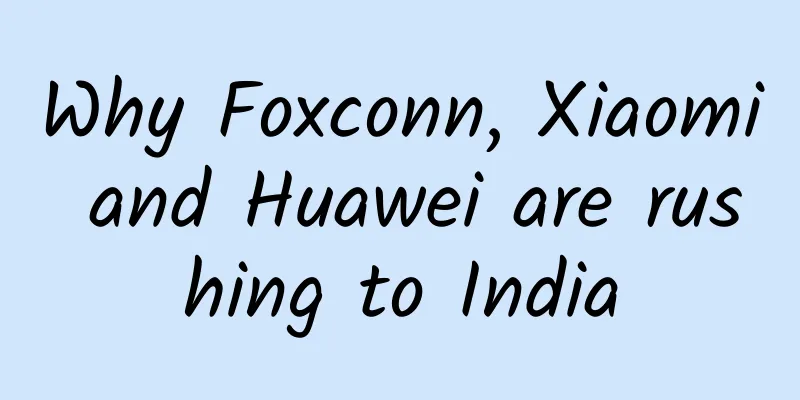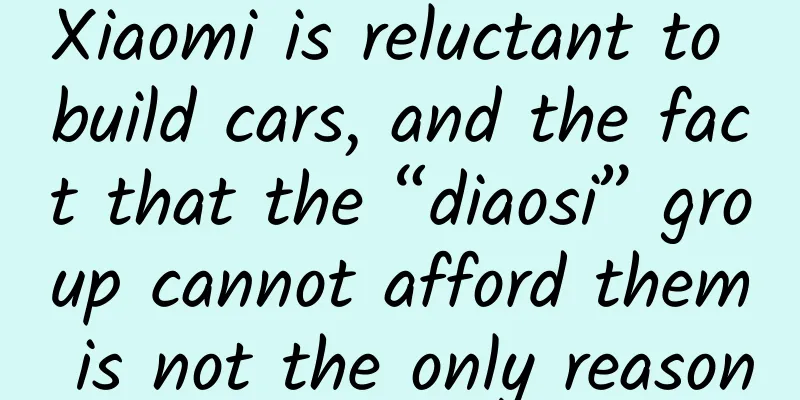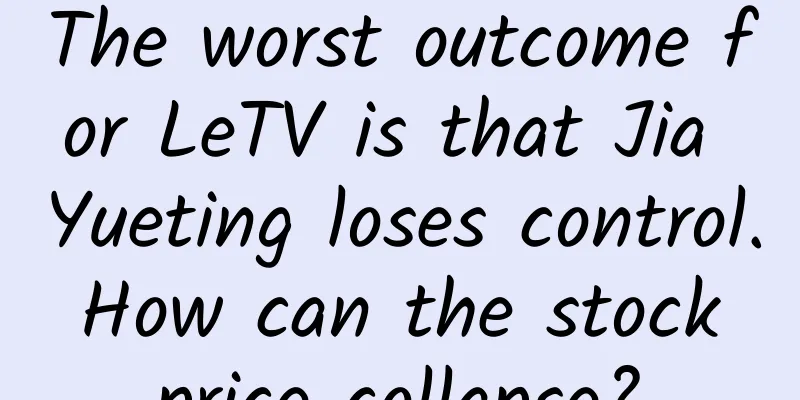Why Foxconn, Xiaomi and Huawei are rushing to India

|
Recently, there was news that Xiaomi has achieved the production and delivery of smartphones in India, also in Foxconn's factory in Andhra Pradesh. Not only Xiaomi, but also "Xiao Hualian" (referring to Xiaomi, Huawei, Lenovo) will produce their own mobile phones in India or other parts of the world. "The company held a mobilization meeting not long ago to mobilize everyone to go to India. The treatment of Chinese employees going there will not be the same as in India, and may even be higher than in China. Of course, there will also be good jobs. Even with such favorable conditions, everyone is still reluctant to go to India. Not only are the living conditions worse than in China, but more importantly, it is a strange place." On July 22, an unnamed Foxconn executive described the big moves being made by Foxconn in an interview with a reporter from 21st Century Business Herald. He said: Although few employees go to India, the company is still trying its best to persuade Chinese employees to work in India, with the goal of training local Indian workers and supporting Indian factories. Over the past three decades, Foxconn has been the world's largest contract manufacturer and the biggest beneficiary of "Made in China": to date, it has built contract manufacturers in Shenzhen, Langfang, Hebei, Zhengzhou, Henan, Chengdu, Sichuan, Taiyuan, Shanxi and other places in China. Except for Langfang, the above-mentioned factories all have more than 100,000 employees, and the total number of employees in China exceeds 1.2 million. Wei Lai, vice president of Xiaomi Technology, said in an interview with a reporter from 21st Century Business Herald: As the company's product sales are globalized, Xiaomi's other resources will also be allocated globally. As for the distribution of manufacturing resources, the nearest market is the most important principle. Only in this way can the transportation costs be greatly reduced. The import tariffs on spare parts are also much lower than those for complete machines. Race to India Recently, the news that Huawei obtained approval from the Indian government to "carry out handheld device manufacturing business in India" has attracted everyone's attention. Foxconn released relevant news on July 15: Foxconn, the world's largest professional manufacturer of electronic products, said that it will expand its development in India on a large scale. The company plans to build 12 new factories in India by 2020 and employ up to 1 million local workers. It is rumored that its investment will reach 20 billion US dollars. The above-mentioned Foxconn executive confirmed the news that Foxconn will set up a production line in India. Foxconn is the largest private employer in mainland China and the world's largest OEM for Apple's iPhone and iPad devices. It operates more than 10 large factories in mainland China, with 1.2 million Chinese employees, accounting for the vast majority of its global employees, making a significant contribution to China's becoming the "world's factory." In addition to manufacturing for Apple, Foxconn also manufactures for Xiaomi. In the 2014 global smartphone shipment ranking, Apple ranked second and Xiaomi ranked fifth. In addition, Foxconn also manufactures for PC manufacturers such as Lenovo, Dell , and HP . Foxconn's setting up of a factory in India has been interpreted in two ways: one is that Foxconn is deploying resources globally and de-Sinicizing; the other is that IT manufacturing resources including smartphones and PCs are globalized, and the "Made in China" mark will become increasingly blurred. In addition to Foxconn, Huawei, the world's fourth largest smartphone manufacturer in terms of shipments, will also build a factory in India. Regarding the topic of de-Sinicization and global layout of IT manufacturing, the 21st Century Business Herald reporter interviewed other OEM manufacturers, including relevant persons in charge of Inventec, Asus, and Wistron. On the one hand, they emphasized China's advantageous position in the global manufacturing industry, such as the maturity of industrial workers and the geographical distribution of the supply chain, but also said that the company currently has no plans in this regard. Why is India the first stop for the global distribution of manufacturing resources? The above-mentioned Foxconn staff said: The most important reason is the huge potential for the Indian market. India is a populous country with a population of 1.2 billion. According to the population growth rate, India may surpass China in the future. According to data, in 2014, India shipped 275 million mobile phones, accounting for 14% of the global market, making it the second largest mobile phone market in the world. However, the shipment of smartphones was only 81 million, and the penetration rate of smartphones was only 30%. Compared with the increasingly saturated domestic smartphone market, India has huge potential for imagination. According to the principle of the nearest market, brand manufacturers are also willing to place factories in India. In contrast, China, where smartphone penetration has surpassed 90%, saw its mobile phone market shrink for the first time in six years in the first quarter of 2015. Currently, Huawei, Xiaomi, Lenovo, ZTE, vivo, OPPO, Gionee, OnePlus and other mobile phones have begun to be sold in India. Xiaomi, Huawei, Lenovo Motorola, Asus and other companies have launched a large number of Android phones priced at US$150 in India, ranking high in sales on e-commerce websites. This is the second "Dragon-Elephant Battle" in the competition for global IT resources: the first occurred after 2000, when the global software industry emerged. India became the world's largest software industry outsourcing destination due to its language and other advantages. China tried to enter this field and focused on developing the software outsourcing industry. Various software parks were even established across the country, such as Beijing, Dalian, Xi'an, Chengdu, etc. Neusoft, Huaxin, and HiSoft became the focus of national support, and various very favorable industrial policies were given to software outsourcing. The final result was that India became the winner, and China failed to snatch the position of "world office" from India. This time, however, it is India, a latecomer, that is attacking China, a leader in manufacturing. Another difference is that China is in the process of industrial transformation and its attitude towards manufacturing has changed, while India is actively pursuing it. What will be the result? The above-mentioned Foxconn executive believes that it is difficult to draw a conclusion at this point. Global Presence The above-mentioned Foxconn executive revealed: In addition to India, Foxconn has built two factories in two provinces in Vietnam, and has decided to build a factory in Brazil, with an initial investment of US$2 billion and an estimated employment of more than 100,000 people. The Brazilian president personally met with Terry Gou and invited Foxconn to build a factory in Brazil, offering various preferential policies. The executive said: It costs at least 10 yuan to ship a mobile phone from China to Brazil, and the cost is as high as 30 yuan. The price of mobile phones in Brazil is generally around 500 yuan. Such high transportation costs account for a considerable proportion of the total cost structure, greatly compressing the profit margin. Building a factory in Brazil can solve this problem. In addition, there is tariff protection for exporting branded mobile phones to Brazil, but building a factory in India can eliminate tariff costs. Because it stimulates employment, the government will also provide various policy subsidies. Samsung is the world's largest smartphone manufacturer by shipments and is also deploying its manufacturing resources around the world. At the end of last year, the Vietnamese government announced that Samsung Electronics ' $3 billion investment plan to build a factory in the country had been officially approved, and Samsung's total investment in Vietnam will be increased to $11 billion in the future. Vietnamese local media estimates that by 2015, Vietnam will be responsible for the production of more than 40% of Samsung mobile phones. In addition to Samsung, in the past few years, mobile phone manufacturing departments of companies such as Intel , Microsoft , South Korea's LG and Japan's Panasonic have also extended to Vietnam. According to official data from Vietnam, Vietnam exported mobile phones and accessories worth US$19.2 billion in the first ten months of last year, an increase of 8% over the same period of the previous year. Vietnam's exports of mobile phones and accessories have exceeded its exports of clothing and textiles, accounting for 16% of Vietnam's total exports. The above-mentioned Foxconn executive believes that Foxconn's building of factories outside of China is the result of the combined effect of several major trends. The first is the two major trends. One is the transformation and upgrading of China's economic structure. The status of traditional manufacturing is being replaced by modern service industries, scientific and technological innovation industries, etc.; the second is the disappearance of China's demographic dividend. China used to be the country with the lowest labor cost and the largest number of laborers. Now the labor cost is much higher than that of other countries, such as India, Vietnam, Indonesia, etc. In terms of labor costs, the costs in India and Vietnam are only a quarter of those in China, and the monthly salary of Brazilian workers is only about 800 yuan. In China, factory wages are at least 3,000 yuan. What's more troublesome is that with the rise of other industries such as the service industry, it is difficult for manufacturing factories to recruit workers; other industries have higher incomes, such as express delivery, where it is not difficult to earn 8,000 yuan or even more than 10,000 yuan, and construction workers earn even more. Since 2008, the labor shortage has been plaguing giant manufacturing companies such as Foxconn. As a winner of Toutiao's Qingyun Plan and Baijiahao's Bai+ Plan, the 2019 Baidu Digital Author of the Year, the Baijiahao's Most Popular Author in the Technology Field, the 2019 Sogou Technology and Culture Author, and the 2021 Baijiahao Quarterly Influential Creator, he has won many awards, including the 2013 Sohu Best Industry Media Person, the 2015 China New Media Entrepreneurship Competition Beijing Third Place, the 2015 Guangmang Experience Award, the 2015 China New Media Entrepreneurship Competition Finals Third Place, and the 2018 Baidu Dynamic Annual Powerful Celebrity. |
Recommend
What is "lip rot"? Don't take it lightly!
Expert of this article: Wang Weibao, Endocrinolog...
To newbies in App operation: Have you tried these App promotion channels?
In the early stage of App operation, how to expos...
How much does it cost to do Baidu bidding promotion?
How much does Baidu bidding promotion cost? How m...
Today is the Lesser Heat. Suddenly, the warm wind arrives.
No need to drink from Heshuo, just brew tea and f...
The fission activity methodology learned from the analysis of activity case writing
Friends who work in operations or marketing will ...
5 major online marketing trends in 2017
Recently, iResearch released the "2017 China...
There are 1.2 million different molecules, and only one can control resistance!
Recently, researchers have achieved the goal of m...
Online Marketing Promotion: How to Spend the Big Money? Fine-tuned operation of large traffic!
0 cost, small budget, replicable, attracting hund...
Android 5.0 is a tragedy: automatic encryption makes the system super slow
On November 24, in response to the endless reques...
2017 Shanghai Auto Show opens, domestic high-end and emerging brands attract attention
At this year's Shanghai Auto Show, domestic a...
Lagou front-end high-paying training camp
Lagou front-end high-paying training camp resourc...
Teach you how to create explosive short videos and easily monetize them
01 Changes in the communication model: From manua...
WeChat JS-SDK Description-Open Interface Description (2)
Hide the upper right corner menu interface wx.hid...
[Creative Cultivation Program] Japan's volcanoes are becoming active. Is this related to the Tonga volcano eruption?
Author: Xiao Long Since the beginning of 2022, vo...
Inventory: Three underlying logics of e-commerce growth in 2019
This article reviews the growth of e-commerce in ...









